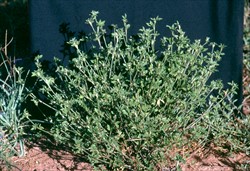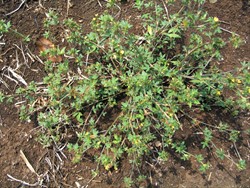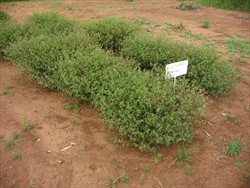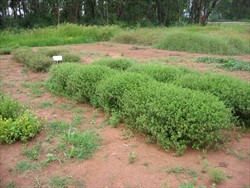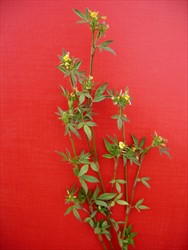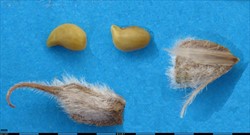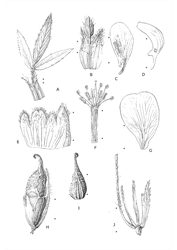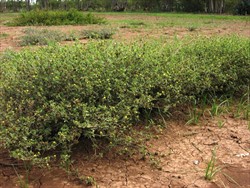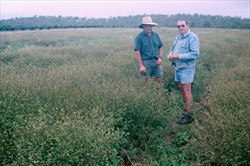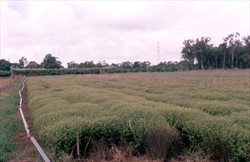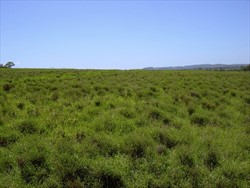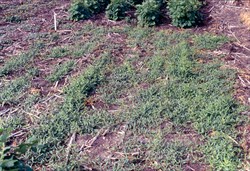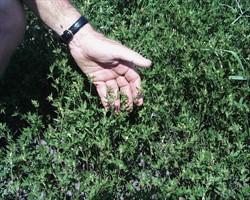Stylosanthes seabrana
Tropical Forages
Stylosanthes seabrana B.L. Maass & 't Mannetje
Family: Fabaceae (alt. Leguminosae) subfamily: Faboideae tribe: Dalbergieae subtribe: Stylosanthinae.
Perennial (plants living 2‒4 years) with woody base; younger stems pilose on one side, viscid bristles (>1 mm) near the nodes. Stipules pilose, very bristly, long lateral bristles present on stipule teeth, but rarely with a terminal bristle; if so, very short. Leaves trifoliolate; leaflets lanceolate to elliptic acute, upper surface glabrous, lower surface glabrescent, except for long often viscid bristles on the midrib below and on the margins; veins raised, prominent below, whitish. Inflorescence small capitate spike with several papilionaceous flowers with obovoid sulphur-yellow standard; each flower surrounded by a trifoliolate outer bract and two inner bracteoles, ciliate at the apex; outer bract bristly, pilose on the margins. Pod (loment) with 2 articles, both usually fertile; upper article 4‒5 mm long (including recurved beak or hook 1‒2 mm long), appressed pilose to woolly, the lower article 2‒3 mm long, densely pilose. Axis rudiment 7‒8 mm long, pilose. Seed asymmetrically reniform, 1.5 mm long, cream-coloured. About 450,000 seeds-in-pod and 690,000 dehulled seeds per kg. Numerical classification of a number of S. seabrana lines revealed two forms within the species:
- a prostrate, low-yielding, anthracnose-susceptible form
- a more erect, high-yielding, anthracnose-resistant form (the two Australian cultivars were selected from this group.)
Similar species
S. seabrana: Leaflets lanceolate/narrowly elliptical, glabrous except for long bristles on the margins and midrib and prominently raised veins on the lower surface; axis rudiment 7‒8 mm long; seed cream coloured.
S. scabra: Leaflets elliptical to obovate, pubescent with bristles at least underneath or on the margins without prominently raised veins on the lower surface; axis rudiment 4‒5 mm long; seed fawn to light brown in colour.
English: caatinga stylo, aff. scabra.
Native:
South America: Brazil (Bahia, Minas Gerais)
Cultivated:
Australasia: Australia (Queensland)
Soil requirements
Occurs mainly on medium to heavy textured red or yellow earths in Caatinga vegetation (variable deciduous forest and thorny thicket in the interior of northeastern Brazil, growing in an area of erratic rainfall and, in places, arid conditions). Adapted to a wide range of soil types, particularly heavy clays, but also clay-loams, loams and sandy-earths, but not sands. Prefers more fertile soils, but can accommodate soils that are fairly low in phosphorus and calcium and is often found at the same sites as S. scabra in its natural distribution.
Moisture
The caatinga biome of northeastern Brazil, where this species originates, occupies an area of approximately 800,000 km², and it is typified by a long dry season and irregular rainfall. This xeric shrubland and thorn forest comprises primarily small, thorny trees that shed their leaves seasonally, with cacti, thick-stemmed plants, thorny brush, and arid-adapted grasses making up the ground layer. Collection data show that current accessions come from areas with an annual rainfall range of (300‒) 600‒900 (‒1,190) mm with a 2‒7 month dry season. Research shows that evaluated ecotypes are well-adapted to tropical and subtropical environments with 500‒1,000 mm summer-dominant rainfall, growing best in years with a long growing season. They are very drought tolerant but do not grow in seasonally flooded soils.
Temperature
Has been collected from 9°54' S in Bahia to 17°31' S in Minas Gerais in Brazil at 250‒1,050 m asl. Although of tropical origin, it is much more frost tolerant than either S. scabra or S. hamata, withstanding night frosts down to -8 °C by developing crowns below the soil surface. Does not grow in cool temperatures and drops leaves in winter, although basal stems can remain green if moisture is available and frosts are not severe. Plants that are frosted to ground level regrow when moisture and temperature conditions are suitable in spring. Seedlings may die during heatwaves in early summer. The cultivars have succeeded in cultivation to at least 27º latitude (300 m asl).
Light
In view of its origins in Caatinga scrubland (see "Moisture" above), it might be assumed that at least some ecotypes of S. seabrana have some degree of shade tolerance.
Reproductive development
In the southern hemisphere tropics, both cultivars began flowering in early February after sowing in December, with peak flowering in March and April, and large numbers of mature pods present from early May, with 'Primar' more advanced than 'Unica'. 'Primar' flowers 2‒4 weeks earlier than 'Unica' in the establishment year, and can be harvested early July and 'Unica' in late July. Appears to flower and set seed through much of the growing season in subsequent years.
Defoliation
Seeds well, developing a large bank of soil seed, with seed lasting in the soil for 2 or more years. Seedling cohorts appear with each rainfall event during the warm season. Management needs to favour development of occasional seedling cohort to ensure maintenance of legume component. Best achieved by reducing shading effect of taller grasses, being careful not to cause permanent damage to the grass since S. seabrana, once established, is more tolerant of heavy grazing than many associated grasses. Heavy grazing early in the growing season favours the stylo, while light grazing or spelling at this stage favours the grass component.
Fire
As with many Stylosanthes spp., fire may provide a useful tool in stimulating germination of soil seed reserves to enhance legume population density, particularly in those accessions with a genetic propensity to produce hard seed.
Guidelines for establishment and management of sown forages.
Establishment
Hard seed levels in S. seabrana are usually much lower than in other stylos such as S. scabra and S. hamata, although some types can have >70% hard seed and may require scarification to achieve 50% germination. S. seabrana has a highly specific inoculum requirement, not nodulating effectively with native strains of rhizobia in some countries. CB 3481 strain Bradyrhizobium is used in Australia. Poor nodulation may not be evident initially on fertile soils, as the legume utilises nitrogen mineralised during land preparation. Nitrogen deficiency symptoms, including poor growth, yellowing of older leaves, and poor seed set, develop as available soil nitrogen declines, if the correct Bradyrhizobium strain is not present. The effective strain can be introduced by inoculating seed in a preceding winter crop such as wheat, prior to sowing uninoculated S. seabrana .
Early sowing is recommended to give sufficient time for larger plants to develop and more seed to mature in preparation for the initial dry season or winter. The small, dehulled seeds should be planted at 1‒3 kg/ha (up to 6 kg/ha in hull), on the surface or no deeper than 1 cm. Best sown into a well-cultivated, fallowed seedbed with good subsoil moisture and weed control. Young seedlings compete poorly with established grasses or vigorous weeds in old cultivation, and sometimes fail when soil moisture is marginal or heat wave conditions occur. Establishment and growth can be slow in the first two years.
Fertilizer
Application of 10‒20 kg/ha P at planting and every 2 or 3 years after establishment to maintain available soil P levels at ±8 ppm (mg/kg) improves both plant and animal performance. Molybdenum and sulphur may also be necessary in some situations.
Compatibility (with other species)
Forms good associations with grasses adapted to clay and clay loam soils under rotational and continuous grazing systems. Competes effectively with, and can suppress weeds such as Heliotropium amplexicaule, a major problem in cultivation on lighter soils.
Companion species
Grasses: Cenchrus ciliaris, C. pennisetiformis, Panicum coloratum
Legumes: Desmanthus bicornutus, Desmanthus leptophyllus, Desmanthus virgatus.[1] [2] [3]
Pests and diseases
High levels of resistance to anthracnose disease caused by the fungus, Colletotrichum gloeosporioides. May require treatment with benomyl if anthracnose develops in seed crops grown in humid environment. No other major problems. Botrytis flower blight caused by Botrytis cinerea, does occur but is not severe. The phytoplasma disease that severely affects seed crops of S. scabra has not been a problem in S. seabrana .
Ability to spread
Initially constrained by lack of appropriate rhizobium, but establishes readily once effective inoculum is present.
Weed potential
High seed production and relatively high levels of hard seed suggest the species may ultimately pose a weed threat once an effective rhizobium strain spreads, although there is no evidence that this has occurred.
Nutritive value
Leaf percentage can decline from over 50% in 6-week regrowth to around 40% at 17 weeks A sample of the terminal 15 cm of shoots of 'Unica' comprising 54% leaf yielded the following results: 23% CP, 0.22% P and 22% ADF in the leaf, 11% CP, 0.17% P, and 38% ADF. Nutrient levels in leaf meal are similar to those for S. scabra, perhaps with a lower tannin level.
Palatability/acceptability
Moderate palatability - generally only lightly grazed, stock preferring the associated green grass leaf. The main contribution is to improve the quality of associated grass and provide higher quality feed as grasses mature in grazing situations and in improving soil fertility for succeeding crops.
Toxicity
None recorded.
Dry matter
In good growing conditions and in pure swards, S. seabrana can produce over 13 t/ha DM during the growing season. DM yields can be higher than those of S. scabra.
Animal production
0.6 kg/hd/day LWG for 10 months of the year from steers grazing a mixed S. seabrana/Panicum coloratum/native grass pasture, equating to over 100 kg/ha/yr LWG for this period. Can give 80‒85% increase in cattle performance over that from unimproved pasture.
Diploid 2n = 20; based on strong evidence, S. seabrana is the putative A genome progenitor of the allotetraploid S. scabra, with S. viscosa the B genome progenitor.
Mature pods from May onwards, with 'Primar' more advanced than 'Unica'. May need to use fertilizer N to compensate for slow nodulation. 'Primar' harvested early July and 'Unica' in late July in north Queensland. Seed holds well in head. Single pass with mechanical harvester can produce about 700 kg/ha of good quality seed in hull with no nitrogen applied, and up to 1,000 kg/ha, particularly if N is applied.
Susceptible to 2,4-D at the seedling stage, but moderately tolerant when mature, with only temporary curling of plants. May also be susceptible to trifluralin, but is tolerant of imazethapyr, which is used in seed crops for pre-emergent grass control.
- Drops leaf in cool/dry season.
- Establishment on heavy textured soils can be problematic if seeds are sown too deeply or if soils surface crusts develop.
- Highly specific rhizobium requirement.
Cook, B.G. and Schultze-Kraft, R. (2020) Clearing confusion in Stylosanthes taxonomy: 1. S. seabrana B.L. Maass & 't Mannetje Tropical Grasslands-Forrajes Tropicales 8:40–47. doi: 10.17138/TGFT(8)40-47
Edye, L.A. and Maass, B.L. (1997) Recent advances in studies of anthracnose of Stylosanthes. I. The biogeography of Stylosanthes hamata, S. scabra and "Stylosanthes seabrana". Tropical Grasslands 31:417–423. bit.ly/2mqiT4n
Edye, L.A., Hall, T.J., Clem, R.L., Graham, T.W.G., Messer, W.B. and Rebgetz, R.H. (1998) Sward evaluation of eleven Stylosanthes seabrana accessions and S. scabra cv. Seca at five subtropical sites. Tropical Grasslands 32:243–251. goo.gl/eDAA7A
Hall, T.J. and Glatzle, A. (2004) Cattle production from Stylosanthes pastures. In: Chakraborty, S. (ed). High-yielding anthracnose-resistant Stylosanthes for agricultural systems. ACIAR Monograph No. 111. Australian Centre for International Agricultural Research (ACIAR), Canberra, Australia. p. 51–64. aciar.gov.au/node/8471
Jansen, P.I. and Edye, L.A. (1996) Variation within Stylosanthes sp. aff. scabra and comparison with its closest allies, S. scabra and S. hamata. Australian Journal of Agricultural Research 47:985–996. doi.org/10.1071/AR9960985
Maass, B.L. and Mannetje, L.’t (2002) Stylosanthes seabrana (Leguminosae: Papilionoideae), a new species from Bahia, Brazil. Novon 12:497–500. doi.org/10.2307/3393129
Marques, A., Moraes, L., Santos, M.A. dos, Costa, I., Costa, L., Nunes, T., Melo, N., Simon, M.F., Leitch, A.R., Almeida, C. and Souza, G. (2018) Origin and parental genome characterization of the allotetraploid Stylosanthes scabra Vogel (Papilionoideae, Leguminosae), an important legume pasture crop. Annals of Botany, 122(7):1143–1159. doi.org/10.1093/aob/mcy113
Pengelly, B.C., Clem, R.L. and Whitbread, A.M. (2004) The role of Stylosanthes spp. in mixed crop-livestock systems in Africa and Australia. In: Chakraborty, S. (ed) High-yielding anthracnose-resistant Stylosanthes for agricultural systems. ACIAR Monograph No. 111. Australian Centre for International Agricultural Research (ACIAR), Canberra, Australia. p. 77–84. aciar.gov.au/node/8471
Vanni, R.O. and Fernandez, A. (2011) The true identity of Stylosanthes seabrana B.L. Maass & L.’t Mannetje (Leguminosae Papilionoideae). Caryologia, 64:247–250. doi.org/10.1080/00087114.2011.10589789
'Primar' (CPI 92838 B) Released in Australia (1996). Origin unknown - contaminant in seedlot. Ascendant habit, dome shaped to 40‒50 cm (erect to 1 m in vigorous, dense stand), with profuse branching. Reddish stems and inflorescence, especially in mature plants. Earlier flowering and more cool tolerant than 'Unica'. Selected for application in the subtropics. Minor anthracnose in the tropics.
'Unica' (CPI 110361, CIAT 10033) Released in Australia (1996). Origin Bahia, Brazil (12.33º S, 41.06º W, 470 m asl, rainfall 960 mm). Erect, vase-shaped growth habit to 40‒50 cm (to 1 m in vigorous, dense stand) green stems. Flowers 2‒4 weeks later than 'Primar', especially in the establishment year. Selected for use in more tropical environments, but has also been found to be persistent and productive under grazing in the sub-humid/semi-arid subtropics. More anthracnose resistant than 'Primar'.
CPI 104710 Selected in Australia. Origin Bahia, Brazil (12.2º S, 42.5º W, 800 m asl, rainfall 680 mm). Similar to 'Unica', vigorous growth, good seed yield, but lower leaf/stem ratio.
CPI 110370 C Selected in Australia. Origin unknown - contaminant in seedlot. Consistently superior to S. scabra cv. Seca in seedling and perennial plant density and yield over all or most sites in the Queensland subtropics.
CPI 115994 Selected in Australia. Origin Bahia, Brazil (12.24º S, 42.28º W, 800 m asl, rainfall 690 mm). Consistently superior to S. scabra cv. Seca in seedling and perennial plant density and yield over all or most sites in the Queensland subtropics.
